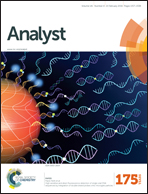A universal strategy for visual chiral recognition of α-amino acids with l-tartaric acid-capped gold nanoparticles as colorimetric probes†
Abstract
The ability to recognize and quantify the chirality of alpha-amino acids constitutes the basis of many critical areas for specific targeting in drug development and metabolite probing. It is still challenging to conveniently distinguish the enantiomer of amino acids largely due to the lack of a universal and simple strategy. In this work, we report a strategy for the visual recognition of α-amino acids. It is based on the chirality of L-tartaric acid-capped gold nanoparticles (L-TA-capped AuNPs, ca. 13 nm in diameter). All of 19 right-handed α-amino acids can induce a red-to-blue color change of L-TA-capped AuNP solution, whereas all of the left-handed amino acids (except cysteine) cannot. The chiral recognition can be achieved by the naked eye and a simple spectrophotometer. This method does not require complicated chiral modification, and excels through its low-cost, good availability of materials and its simplicity. Another notable feature of this method is its high generality, and this method can discriminate almost all native α-amino acid enantiomers. This versatile method could be potentially used for high-throughput chiral recognition of amino acids.


 Please wait while we load your content...
Please wait while we load your content...